Everyday, everywhere, New Zealanders are referred to as Kiwis. On the news, in conversation, at sports games… whenever a New Zealander appears on the scene, you are likely to hear them called “Kiwi”. But why?
In this blog I explore the origins of our popular nickname, ‘Kiwi’. I describe how images of the Kiwi were used to sell products and services, before later becoming a symbol of New Zealand during the first world war, and then, finally, how Kiwi became part of our national identity. Join me as we reflect on some of New Zealand’s key historical moments and learn how New Zealanders came to be known as “Kiwis”.
Introduction
So, why are Kiwis called Kiwis? I mean, the Kiwi is a national icon, sure but isn’t it a little unusual to use that as a nickname? I mean, I would never say, “My friend is a Kangaroo” in place of “My friend is Australian”, right? And I’ve never heard Americans called “eagles” or Brits called “lions”, even though those animals are their national icons. Yet, for some reason, we opt to call New Zealanders “Kiwis”. Seems odd, don’t you think?
What’s more, the Kiwi isn’t even all that prevalent in New Zealand. In fact, I’ve never seen one. I can’t help but wonder if a tui or a kereru might be a better choice for our national icon, since, you know, we can actually see them.
I kept wondering about this. Why on earth are we called “Kiwis”? How did we get this odd nickname? And how did it become so widespread that its used by people around the world. I had to find out. So I did.
Here’s what I learned…
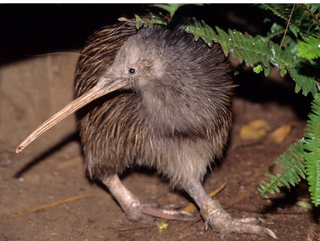
Kiwi. Photo from Sandiego Zoo.

Tui. Photo by Sid Moddell on Flicker

Kereru. Photo by Brendon Doran via Stuff
About the Kiwi
A UNIQUE NATIVE BIRD
So, let’s start with the basics. Let’s talk about Kiwis (the bird, I mean!) The Kiwi bird is a native bird of New Zealand that has several unique characteristics such as its long beak, cat-like whiskers, feathers that look like hair, and the fact it has wings but it can’t fly. They’re pretty small, about the size of the chicken, and are rarely seen due to the fact that: a) they are an endangered species, b) they live in the bush, and c) they are nocturnal, so they only come out night.
Not many people realise this, but the name, “Kiwi” is actually a Māori word. It was given to Kiwis because of the shrill call the male Kiwis make at night. Imagine a high pitched scream… “kii-wiii! kii-wiii!” Get it? So they were called “Kiwi”. If you’re curious, Te Aka Maori Dictionary has a sound recording of the Kiwi call here. (Look for this icon 🔊 in a red circle. It is to the right of the definition)
Anyway, despite it being a bird that can’t fly, makes annoying noises at night, and is rarely seen, it’s a pretty special bird to use New Zealanders, and images of the Kiwi have been used for decades.

Kiwis are nocturnal and so the best time to see them is at night. Photo from Department of Conservation via PBS.org
Kiwi as an emblem
LOGOS, TRADEMARKS & MORE
So as I mentioned, even though we don’t see real Kiwis very often, we see images of Kiwis allll the time! Take, for example, souvenirs. Fridge magnets, key chains, cups… these everyday items are decorated with Kiwis and sold as souvinirs all over the country. You’ve seen them, I bet.
Not only that, but the Kiwi is often used in brand logos, too. For example, the popular clothing brand Canterbury is made with a Kiwi bird silhouette. In this way, the Kiwi is used as an emblem – an image to signify a concept, in this case a clothing company. And this is not just a contemporary thing…
As it turns out, the Kiwi has been used as an emblem for companies and other institutions since wayyy back. As far back as the 1800s, in fact…

The Kiwi appears on a range of souvinirs and household items. Photo from Te Ara – The Encyclopoedia of New Zealand

The iconic rugby shorts by Canterbury NZ

The Kiwi appears on poststamps (1900 ~ ). Photo from New Zealand post via Te Ara – The Encyclopoedia of New Zealand

The Kiwi appears as on a 10 shilling note (1935 ~ ). Photo from Reserve Bank of New Zealand via Te Ara – The Encyclopoedia of New Zealand
From around the second half of the 19th century, images of the Kiwi started to appear on product packaging – vetirinary medicines, seeds, drugs, varnishes, and insurance…to name a few examples. Additionally, Auckland University put a Kiwi on their college crest, NZ post featured the Kiwi on postage stamps, and, most exciting of all, the Kiwi appeared on money! In no time at all, the Kiwi had been adopted as a emblem various New Zealand products and services.
As the Kiwi popped up more and more, it started to be considered something of a national icon. A Kiwi on a product suggested it was locally made, New Zealand owned, and stirred up feelings of national pride. Interestingly, there was no official decision to make the Kiwi a national icon of New Zealand. It just sort of evolved that way.
But anyway, why Kiwis?
At this stage, I’m still wondering why the Kiwi became so popular… Why not another native bird? Well, remember how I mentioned that Kiwis are an endangered species? It turns out that that had a big influence on why Kiwis became our national bird and later, symbol.
With the rise of settlers arriving on New Zealand shores by ship, there was also a rise in pests entering our forests. Stoats, possums, rats, and other animals ate the baby eggs of Kiwi and as a result, the population declined rapidly. As the number of Kiwis decreased, the love of Kiwis increased… In a kind of bittersweet love story, Kiwis started to treasure the Kiwi and so of course, it was the first choice for images on brand logos and emblems like the examples given above.
Additionally, it is also thought that the Kiwi might have been chosen because it was funny-looking (and therefore memorable) and also, easy to draw. I mean, I’ve got to agree, it’s definitely unique!

During the First World War, New Zealand soldiers were increasingly referred to as Kiwis, and they seem to have accepted the name. At the end of the war, when New Zealand soldiers in England were waiting at Sling camp to go home, they kept busy by carving this large kiwi in the chalk hill above the camp. Image by Jill Goodwin via the National Library
Kiwi as a symbol
CARTOONS AND COMMENTARY
Before long, the Kiwi had become a symbol of New Zealand. And in addition to being used as a logo or trademark as we saw earlier, images of the Kiwi started being used to represent New Zealand as a nation. Where? In cartoons…
Now, when I say cartoons, I don’t mean kids’ cartoons. I’m talking about the kinds of cartoons that we see printed in newspapers. You know, the ones that pick a recent event and add commentary to it. Cartoons that reference current affairs – sport, trade, politics, for example, whatever is going on at the time. This is where we started to see Kiwis used to symbolise the country of New Zealand.
For example, after a big rugby game where New Zealand beat Great Britain, a cartoon was published of a Kiwi growing into a Moa. A Moa, by the way, is a now extinct New Zealand bird that looks similar to a Kiwi, only it’s huge – I mean, taller than you! The idea was to show the Kiwi growing bigger, better and stronger after their victory. In this way, the Kiwi represented the New Zealand sports team, and by extension, New Zealand as a whole. Then, just a year later, the Kiwi was featured once more. This time the topic was politics, and in the cartoon we see a Kiwi and Kangaroo going to a colonial conference. They, of course, represented the Australian and New Zealand government, who had recently been at a conference together.
The Kiwi was used again and again in these sorts of cartoons, and as it did so it became a clear symbol of New Zealand – a bird to to represent the nation. Interestingly, the Moa, another flightless bird native to New Zealand, also featured in these kinds of cartoons, but it soon went extinct and so the Kiwi became number one. (Aha! I knew there had to have been other birds competing for national icon status! 😉) Other symbols that were used for New Zealand around that time included fern leaves, a small boy, and a lion cub. Slowly but surely, though, the Kiwi took over as the main symbol of New Zealand.
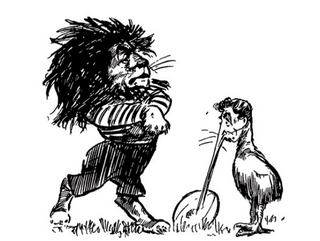
A Kiwi morphs into a Moa. This cartoon was printed in 1904 after the All Blacks defeated Great Britain in the first rugby test between Motherland and colony. Cartoon by J.C. Blomfield via NZHistory.govt.nz
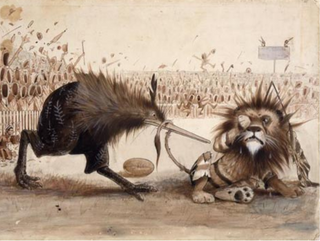
A cartoon celebrates the win of New Zealand rugby team over an Anglo-Welsh team in 1908. Cartoon by by Trevor Lloyd via Te Ara – The Encyclopoedia of New Zealand
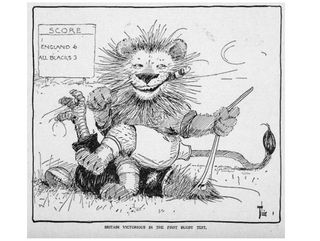
We can’t always be winners! This cartoon was in the New Zealand Herald in 1930 after the All Blacks lost to England. Cartoon by Trevor Lloyd via the National Library.
Kiwi as a nickname
WORLD WAR I
So, let’s recap. We’ve looked at how images of the Kiwi bird were used as an emblem, then a national symbol, and then…? Well, next up, a nickname. How did we go from using the Kiwi to represent New zealanders, to saying a Kiwi is a New Zealander? Well, believe it or not, the First World War played a big role in the evolution of our nickname.
When New Zealanders went off to war, they took with them the image of, you guessed it, the beloved Kiwi. Images of the Kiwi were on the military badges of several regiments, and also on a boot polish that soldiers used regularly. With these images around nearly everywhere you look, at some point, New Zealand soldiers were given the nickname “Kiwi”.
It’s impossible to say who said it first. My bet is that we got the nickname from an allied soldier…perhaps an Aussie or Briton who sat next to a New Zealander and said something like, “Hey Kiwi, pass me a biscuit” I mean, that’s my guess. Regardless of who said it first, before long, everyone was saying it…
Initially, “Kiwi” was only used to refer to soldiers from New Zealand, but over time, it was extended to refer to all people from New Zealand. And the nickname seems to have stuck, cos we’re still using it over seven decades later!
Oh, and apparently before “Kiwi” was adopted as a nickname for New Zealanders, other nicknames included “Enzeders”, “diggers”, “pig-islanders”, “Maorilanders” or “Fernleaves”. That is truly well before my time though cos I’ve never heard anything like that before! And I gotta say, I’m glad they were left in the past…
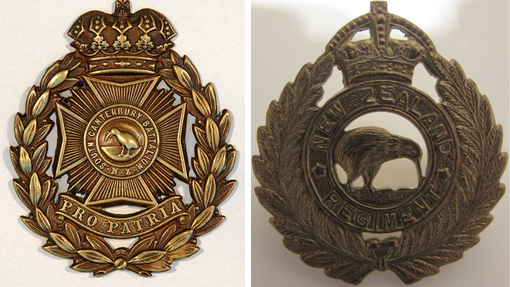
(1) – South Canterbury Batallion Badge. Photo from Te Ara – The Encyclopoedia of New Zealand (2) New Zealand Regiment Badge. Photo from Kiwisoldier.wordpress.com

The Kiwi became an official symbol of the Royal New Zealand Air Force in the 1960s, although it was used for many years before then. Photo by Jock Phillips via Te Ara – The Encyclopoedia of New Zealand
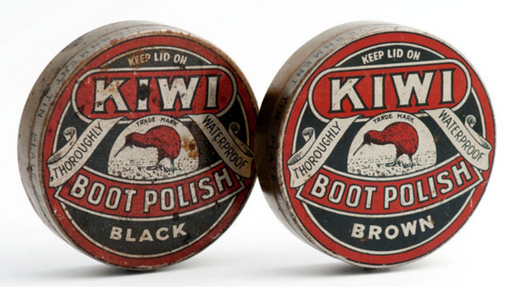
The iconic ‘Kiwi’ boot polish that soldiers used regularly. Ironically, it’s actually an Australian owned company! The founder named it ‘Kiwi’ after the birthplace of his wife. Photo by David Pratt via Brancoandbull.com

At the end of the war, when New Zealand soldiers in England were waiting at Sling camp to go home, they kept busy by carving this large kiwi in the chalk hill above the camp. Image by Jill Goodwin via the National Library
Kiwi as a national identity
KIWIS IN THE 21ST CENTURY
Fast forward to the present day and “Kiwi” is used interchangeably with “New Zealander”. In fact, I’d guess that “Kiwi” is even more common. And we see and hear it everywhere – on the news, at the pub, in the Olympics…whenever New Zealanders are involved, there’s a good chance they’ll referred to as Kiwis.
Now, something interesting that I uncovered when researching for this blog post was how people feel about being called “Kiwi”, and specifically, whether or not they actually identify as Kiwi. While “Kiwi” is widely used to talk about New Zealanders both nationally and internationally, not everyone is happy about it.
On one side of the fence, there are people who argue that the term “Kiwi” carries a stereotypical image of what it means to be a New Zealander…white, middle-class, loves rugby, works on the farm, drinks beer… you get the picture. While that stereotype might be true of some New Zealanders, it fails to represent minorities and, really, anyone who doesn’t fit the mould. As a result, it’s criticised for not being inclusive of our diverse population. As an alternative, some people prefer to identify as Māori, Pākehā, New Zealander, Chinese-New Zealander, and so on.
On the other hand, others argue that “Kiwi” is inclusive, and can be used to celebrate all New Zealanders, whatever their heritage, under one umbrella. They stress that the term “Kiwi” helps them to connect with their lived experience of growing up in New Zealand, and is more about their cultural connection to New Zealand rather than their biological race or family heritage.
It’s an interesting point to consider, and when hearing these perspectives, I was confronted with the reminder that actually, New Zealand has a pretty shameful history of racism (colonisation, Asiatic Restriction Bill, Dawn Raids, to name a few examples) and ongoing problems with racism, so maybe there’s something to be learned here. I think we can all agree that we want a nickname like “Kiwi” to include rather than exclude people, so it’s important to hear these perspectives and learn from others’ experiences.
Anyway, that requires a deep dive into an entirely new topic, so rather than writing any more on it I will include some links below to further reading if you’re interested. For now, just keep remember that while most people identify as Kiwi, not everyone does, so just be mindful.
Conclusion
And so, that brings us to the end! To sum up, we learned that “Kiwi” is a longstanding nickname that dates back to roughly World War 1, although the Kiwi bird had already been used in various forms of symbolism since well before then. We reflected on how, when, and where the term “Kiwi” is used, and some of the attitudes towrads the nickname within New Zealand. I, for one, learned a lot writing this blog, and I hope you did too!
Further learning
RECOMMENDED RESOURCES
While putting this blog together, I learned so much about New Zealand history, national identity, and of course, the Kiwi bird. I found a lot on the Te Ara website, and there are plenty more stories available online for free! Some stories you might like include “The New Zealanders” and “Kiwi“.
When writing about attitudes to the nickname “Kiwi” I drew from conversations with friends and family, opinions shared online in articles and on social media. Below are some opinion pieces you might find interesting. There’s also lots of discourse on Tiktok. Search “Kiwi” to see what you find!
“Don’t call me Kiwi” by Kennedy Warne (NZgeo)
Kennedy Warnes quotes a respected kaumatua who says “The biggest insult you can put on a tangata Māori is to call him something you can eat.” Read it here
“Call me a Kiwi – not an Indian or Pakeha” by Matt Samra (NZherald)
Matt Samra writes about his upbringing in Auckland and why he called himself
Kiwi. Read it here.
Sources
Jock Phillips (2005, 8 Feb), The New Zealanders, Te Ara – the Encyclopedia of New Zealand. http://www.TeAra.govt.nz/en/the-new-zealanders
Jock Phillips (2007, 24 Sep), Kiwi, Te Ara – the Encyclopedia of New Zealand. https://teara.govt.nz/en/kiwi






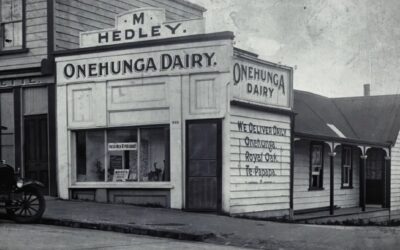
0 Comments